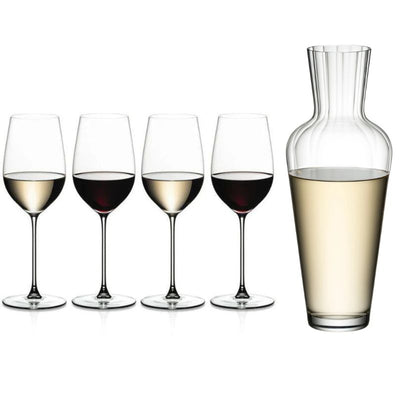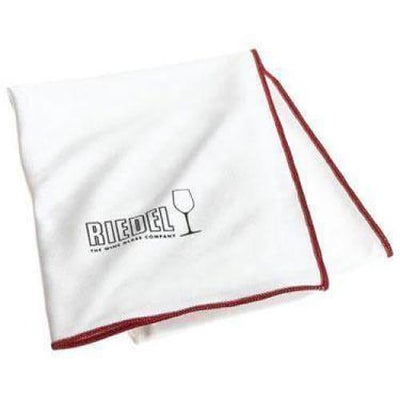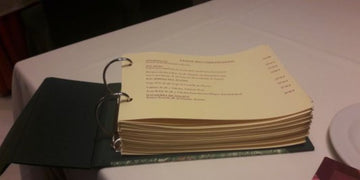The Science Behind Wine Glass Shapes

The Science Behind Wine Glass Shapes: Why It Actually Matters
As I mentioned a few years back, Emma, my other half, makes wine at home. She started in 2017, when our new allotment (which had been neglected for a good five years) provided a bumper harvest of gooseberries, blackberries, redcurrants, blackcurrants and grapes.
There was, initially, a bit of trial and error, a lot of reading and a few tortured taste buds!
In This Guide
Very quickly though she developed, so it seems to me, an almost supernatural feel for the process. Juggling (sometimes bizarre) ingredients, sugar, water, alcohol content, yeast, pectolase, eye of newt, toe of frog (oh.. hang on, that's Macbeth), to produce staggering amounts of very drinkable wine.
I'm typing this in our spare bedroom / office / wineroom to the accompaniment of the gentle bubbling of airlocks on demijohns, containing Dandelion Wine (lovely honey notes), Freezer Wine (the result of our freezer breaking down and being left with thawed out bags of soft fruit), and Jam Wine (made from a dozen jars of various jams, as she needed the space in the Jam Cupboard for the Gherkin Ketchup she made last week).
🍷 The Homemade Wine Test: We drink a lot of wine that doesn't have the benefit of tasting notes on the label, or even a label at all. Part of the fun of the first bottle of a new batch is working out which glass is best to drink it from.
The reason for sharing all this with you is that, as you can imagine, we drink a lot of wine that doesn't have the benefit of tasting notes on the label, or even a label at all. Part of the fun of the first bottle of a new batch is working out which glass is best to drink it from. To do this, we need some understanding of why wineglasses are different shapes.
The Science Behind Glass Shape: What We Now Know
Since I first wrote about wine glasses, new research has emerged, and it finally validates what enthusiasts have long suspected.

Ethanol (red = bad) and wine aromas (green = good) escaping from a wine glass rim
In 2015, Japanese scientists at Tokyo Medical and Dental University developed a camera system that could visualise ethanol vapour escaping from wine glasses, providing unprecedented insight into how glass shape affects wine enjoyment.
As this developed, their research revealed that at proper serving temperature (around 13°C), the alcohol concentration in the centre of a wine glass was lower than that around the rim, creating a ring-shaped vapour pattern that allows us to enjoy wine aromas without interference from gaseous ethanol.
While scientific studies have provided somewhat mixed results - with some research showing subtle effects rather than dramatic differences - the consensus is clear: glass shape does impact our perception of wine, primarily through how it affects aroma delivery rather than actual taste.
The unique shape of a wine glass concentrates the actual aromas of the wine into the centre of the glass while ethanol remains around the rim, away from the nose.
🧠 Science Update: It's worth noting that the old "tongue map" theory - which suggested different parts of the tongue detect different tastes - has been largely debunked. Modern neuroscience tells us that taste perception is far more complex, with smell playing the dominant role in what we experience as "flavour."
The Four Essential Features of a Wine Glass
From the bottom to the top, each element serves critical roles:
The Base
Makes sure the glass doesn't fall over. Revolutionary stuff.
Don't cry over spilt milk, but spilt wine is another story. A wider base also provides greater stability, particularly important for larger-bowled glasses.
The Stem
Keeps your hands off the bowl so you don't warm the wine, crucial for chilled whites. It also keeps hand soap and moisturiser scents away from your nose while you're trying to detect those delicate honey notes in the Dandelion Wine.
Some professionals hold the base rather than the stem for this reason, achieving maximum distance from potential interference.
The Bowl
Where the wine sits and the swirling happens. A bowl wider than the rim lets you release aroma compounds without redecorating the table. Larger bowls mean more surface area for aromatics to escape.
Fill no more than a third full, unless you enjoy explaining wine stains on the carpet to your other half!
The Rim
Thinner is better. A delicate rim lets you focus on the wine rather than the sensation of glass against your lips. High-quality crystal glasses have rims so thin they're barely there, a detail that matters considerably more with the 2015 Château Margaux than with a demijohn of something made from defrosted berries.
White Wine Glasses
White wines are usually served in smaller bowled glasses. Smaller glasses:
- Preserve floral aromas
- Maintain cooler temperature
- Express more acidity in wine
- Deliver more aromas (even at cooler temperatures) due to proximity to the nose
There are exceptions of course.
Full-bodied white wines like oak-aged Chardonnay, White Rioja, and orange wines benefit from a larger bowl. The larger bowl, originally introduced by Riedel as a "Montrachet" glass, better emphasizes a creamy texture because of the wider mouth.
Red Wine Glasses
The choice of a red wine glass has a lot to do with mitigating the bitterness of tannin or spicy flavours to deliver a smoother tasting wine. After years of tasting wines from different glasses, it's clear that red wines tend to taste smoother from a glass with a wide opening.
Of course, the distance to the actual fluid affects what you smell.
Large "Bordeaux" Glass
This glass shape is best with bolder red wines, such as Cabernet Sauvignon, Cabernet Franc, Merlot or Bordeaux Blends.
- Delivers more aroma compounds vs. the burn of ethanol from being farther from nose
- Larger surface area to let ethanol evaporate
- Wider opening makes wines taste smoother
"Burgundy" Glass
A great choice for lighter, more delicate red wines with subtle aromas. The large round bowl helps collect all the aromas. Try this glass shape with Pinot Noir, Gamay, Burgundy, Valpolicella blends, and even Nebbiolo.
As a general rule of thumb - a wider opening de-emphasizes overpowering aromas; a narrower opening concentrates subtler ones.
The Rise of Universal Wine Glasses
One of the most significant trends in recent years has been the growing popularity of universal wine glasses (versatile glasses designed to work well with multiple wine styles). This addresses a practical concern: most wine drinkers don't want to invest in (or store) a dozen different glass shapes.
While these glasses strike a balance between the features needed for different wine styles - offering enough bowl size for red wine aeration while maintaining the focus needed for white wine aromatics, they are always a compromise when compared to a well designed varietal specific glass.
Stemless vs. Stemmed: The Eternal Debate
Perhaps no wine glass topic generates more discussion than the stemmed versus stemless debate. Stemless wine glasses have surged in popularity over the past decade, and the debate has moved beyond mere aesthetics to encompass practicality, occasion, and wine quality.
The Case for Stemless
Stemless glasses offer several compelling advantages:
- Durability: Without a delicate stem, these glasses are far less likely to break - ideal for outdoor gatherings, casual settings, or households with children
- Storage: They store more easily and require less vertical space
- Dishwasher-friendly: Most stemless glasses can safely go in the dishwasher
- Versatility: They work beautifully for water, cocktails, and casual wine drinking
- Modern aesthetic: Their clean, minimalist design appeals to contemporary tastes
- Stability: The lower centre of gravity makes them harder to knock over
The Case for Stemmed
Traditional stemmed glasses remain preferred by wine purists for good reasons:
- Temperature control: Essential for white wines and champagne, which must be served chilled
- Aroma preservation: Keeping hands away from the bowl prevents unwanted scents from interfering with the wine's bouquet
- Easier swirling: The stem provides better control for proper wine aeration
- Visual clarity: Holding the glass by the stem keeps the bowl free of fingerprints, allowing you to appreciate the wine's colour and clarity
- Formality: Stemmed glasses convey elegance and are expected at wine tastings and formal occasions
The Verdict
The choice comes down to context and wine quality. For fine wines, particularly whites and champagnes that need temperature control, stemmed glasses are objectively superior. The stem prevents your hand from warming the wine, keeps fingerprints off the bowl, and makes proper swirling easier. For wine tastings or when serving expensive bottles, stems are non-negotiable.
For everyday drinking, casual gatherings, or outdoor settings, stemless glasses offer practical advantages without significantly compromising the experience, especially with red wines served at room temperature. Many wine enthusiasts now maintain both types: stems for serious wines and occasions, stemless for relaxed enjoyment.
Does It Really Matter?
Andrew Rastello, the assistant wine director at Eleven Madison Park in New York, pours from a 200-page wine list into 17 different Riedel shapes. "For a customer to have a different glass for red Burgundy, versus Napa Cab, versus Bordeaux, it's a luxury," he says, "but I believe it makes a drastic difference to the experience of the wine."
I couldn't agree more, Andrew.
The science supports what our experience tells us: while the wine itself is paramount, the glass through which we enjoy it genuinely matters. It's not pretension, it's physics, chemistry, and sensory science working together to enhance our enjoyment.
That said, let's keep perspective. The best glass is the one that makes you want to drink wine and enjoy it. Whether that's a £90 hand-blown Sommeliers or a stemless tumbler on the patio, the goal is the same: to appreciate and enjoy what's inside.
And Don't Forget to Decant!
Regardless of which glass you choose, decanting remains one of the most effective ways to improve many wines, particularly young reds and aged wines with sediment.
The increased exposure to oxygen helps soften tannins, open up aromas, and integrate flavours.
Now, where's that 2018 courgette, gooseberry and satsuma wine?
I think I'll start with the Riedel Veritas Riesling glass for this one, versatile enough to handle whatever Emma's creativity has produced, and elegant enough to honour the effort that went into it.
Though let's be honest, after a few glasses of Jam Wine, I could probably be drinking it from a jam jar and still think it's magnificent.
Cheers!
























Leave a comment